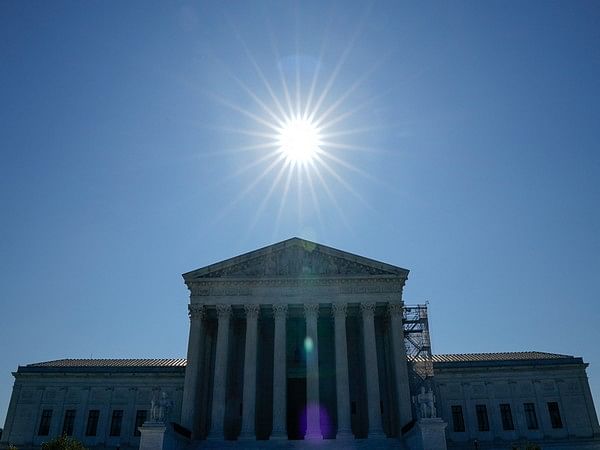Washington, DC [US], June 14 (ANI): The US Supreme Court struck down a federal ban on bump stocks implemented during the administration of former President Donald Trump.
This ruling represents the latest instance of the high court curbing the authority of federal agencies to enact regulations autonomously, CNN reported.
Justice Clarence Thomas penned the majority opinion for a 6-3 court, with the dissent led by Justice Sonia Sotomayor and joined by the liberal wing of the court.
Trump had advocated for the ban following a tragic mass shooting in 2017, where 58 individuals lost their lives during an outdoor music festival in Las Vegas. Bump stocks enable a shooter to modify a semi-automatic rifle into a weapon capable of firing at a rapid rate, potentially hundreds of rounds per minute.
“A bump stock does not convert a semiautomatic rifle into a machinegun any more than a shooter with a lightning-fast trigger finger does,” Thomas articulated in the opinion. “Even with a bump stock, a semiautomatic rifle will fire only one shot for every ‘function of the trigger.'”
The legal challenge to the ban was initiated by Michael Cargill, a gun store owner from Texas, who acquired two bump stocks in 2018, surrendered them to authorities after the ban’s enactment, and subsequently filed a lawsuit to reclaim them. Under federal regulation, possession of a bump stock became a punishable offense, carrying a penalty of up to 10 years in prison.
While the case did not directly hinge on Second Amendment rights, it reignited the discourse surrounding firearms within the judicial sphere, marking one of the most closely monitored legal disputes of the year. Consequently, the decision aligns with a pattern of the Supreme Court’s rulings favouring the interests of gun rights advocacy groups, as reported by CNN.
Sotomayor, dissenting vehemently, expressed concern over the majority’s decision, foreseeing dire consequences. She remarked, “The decision hamstrings the Government’s efforts to keep machineguns from gunmen like the Las Vegas shooter.”
In an uncommon move underscoring her dissatisfaction with the verdict, Sotomayor chose to deliver her dissent orally from the bench on Friday, emphasising the gravity of her disagreement.
Sotomayor’s dissent articulated, “When I see a bird that walks like a duck, swims like a duck, and quacks like a duck, I call that bird a duck. A bump-stock-equipped semiautomatic rifle fires ‘automatically more than one shot, without manual reloading, by a single function of the trigger.’ Because I, like Congress, call that a machinegun, I respectfully dissent.”
The legal dispute revolving around bump stocks bears an indirect connection to gun control legislation enacted by Congress in the 1930s, initially targeting notorious figures like Al Capone and John Dillinger. In response to violent crimes involving machine guns, lawmakers mandated the registration of such weapons.
Over the years, amendments to the law culminated in a prohibition on the transfer or possession of machine guns under most circumstances by 1986. Crucially, the revised law defined a “machine gun” as a firearm capable of firing more than one round with “a single function of the trigger.” The interpretation of this phrase constituted the crux of the legal challenge.
Both the Trump and Biden administrations, along with gun control advocates, contended that the operational mechanism of bump stocks qualifies them as machine guns. In 2018, the Bureau of Alcohol, Tobacco, Firearms and Explosives reclassified bump stocks as machine guns, thereby proscribing their purchase or ownership based on existing legislation.
Former President Trump characterised bump stocks as devices that transform “legal weapons into illegal machines.”
It’s estimated by the ATF that between 2010 and 2018, approximately 520,000 bump stocks were sold. These accessories replace the standard stock of a semiautomatic rifle, facilitating automatic-like firing through the rifle’s recoil if the shooter maintains pressure on the trigger.
Opponents of the ban argued that the ATF overstepped its jurisdiction with the reclassification, highlighting the agency’s longstanding stance, under both Democratic and Republican administrations, that bump stocks fell outside the purview of existing laws.
Initially, a US District Court in Texas and a panel of judges from the conservative 5th US Circuit Court of Appeals sided with the Justice Department. However, upon rehearing, the full 5th Circuit issued a fragmented opinion last year, favouring Cargill’s position.
During oral arguments in late February, the Supreme Court appeared divided on the issue. Several conservative justices expressed reservations, particularly regarding the potential retroactive prosecution of individuals who acquired bump stocks before their classification as machine guns.
Justice Brett Kavanaugh voiced concerns over the unintended consequences of criminalising possession retroactively, cautioning against ensnaring unsuspecting citizens in legal jeopardy.
Another central point of contention was whether Congress, rather than the ATF, should have jurisdiction over the ban’s imposition. This question echoes broader debates within the Supreme Court concerning regulatory authority, observed in various contexts such as financial and environmental regulations, according to CNN.
In a meticulous examination characteristic of the case’s technical complexity, Justice Thomas delved into the mechanics of semi-automatic rifles, elucidating the distinction between bump stocks and automatic weapons.
His opinion emphasised the manual input required for firing multiple shots with a bump stock-equipped rifle, contrasting it with the continuous automatic fire of a genuine machine gun.
“Firing multiple shots using a semiautomatic rifle with a bump stock requires more than a single function of the trigger,” Thomas elucidated, highlighting the nuanced operation of these devices.
The Supreme Court’s decision to invalidate the bump stock ban underscores ongoing debates surrounding gun control, agency jurisdiction, and constitutional interpretation, leaving significant implications for future regulatory actions and legal challenges in the realm of firearms legislation, CNN reported. (ANI)
This report is auto-generated from ANI news service. ThePrint holds no responsibility for its content.



